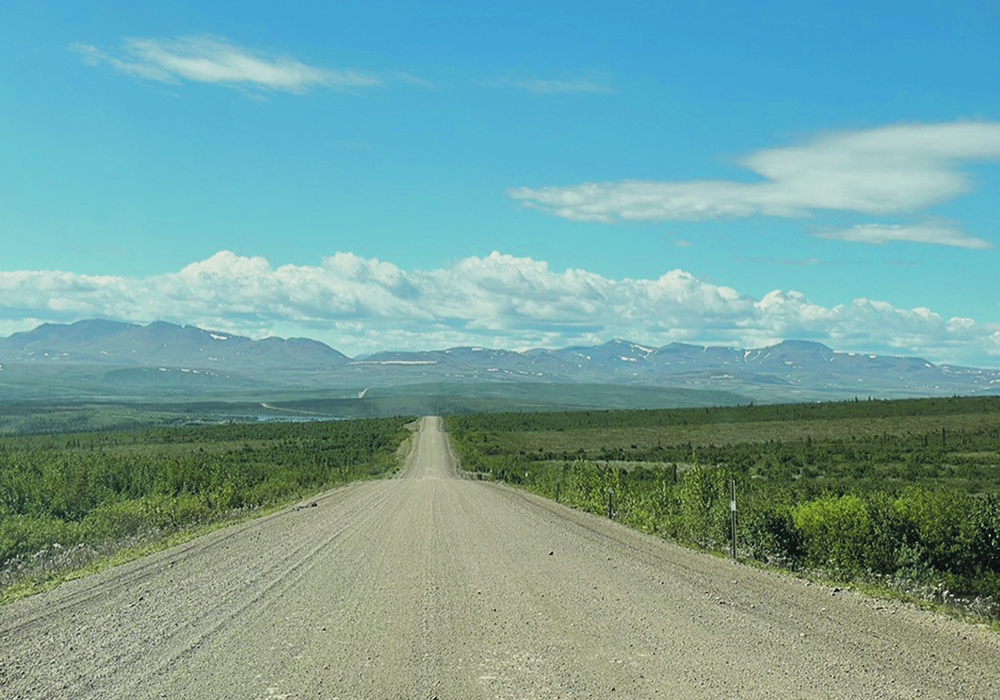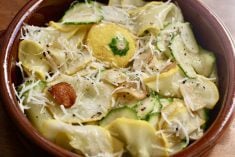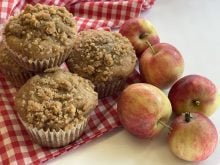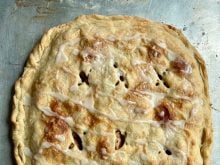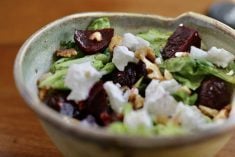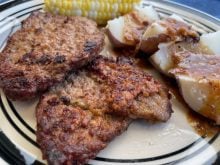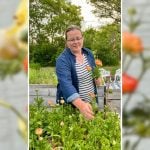In June, we checked off some items on our bucket list, travelling to two of the three Canadian territories and touching the Arctic Ocean. We have now been to all the Canadian provinces and territories except Nunavut, and we have travelled from sea to sea to sea by road in Canada.
It was a wonderful, leisurely month-long driving trip that gave us time to meet interesting people and to enjoy the beautiful scenery and wildlife. The decision to travel in June meant that we avoided the mosquitos, black flies and holiday traffic.
Another bonus was that we experienced the summer solstice. The 24 hours of daylight was fascinating to experience and a little unsettling to the natural body rhythms.
A highlight for us was driving the gravel, 740 kilometres of the Dempster Highway through the Yukon, across the Arctic Circle, into the Northwest Territories, to Inuvik. We continued another 124 km to Tuktoyaktuk and the Arctic Ocean, where I dipped my toes in.
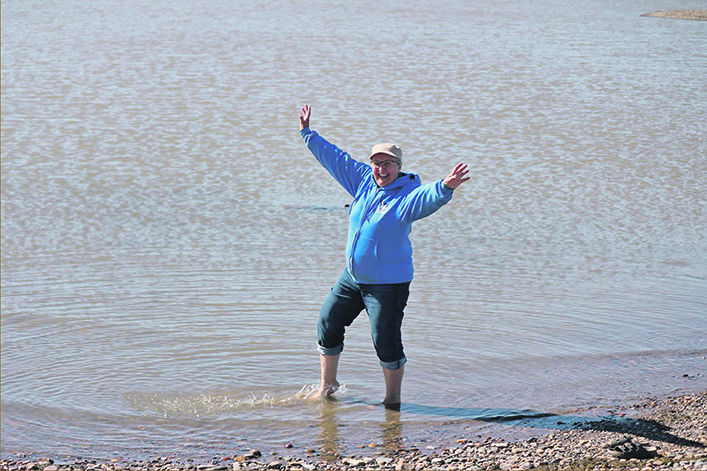
In 2017, when the road between Tuktoyaktuk and Inuvik was complete, Tuk became the only community on the Arctic Ocean connected to the rest of Canada by road.
The horizon-to-horizon sky is a beautiful bright blue and the air seemed fresh and pure. The landscape is so beautiful and pristine with only the gravel road winding around soft glacier-rounded mountains, across rolling tundra plains and through broad river valleys.
There is the occasional microwave tower, road maintenance shop and a few campgrounds with only one service and accommodation point available at Eagle Plains, set high on a rocky plateau.
A gravel road, that is better maintained in some sections than others, means you drive cautiously to avoid the potholes. We met a surprising number of motorcyclists who seemed to take biking the Dempster Highway as a badge of honour. There are semis because they are the only supply line for goods to Inuvik and the Indigenous communities that are mainly between the Mackenzie River ferry and Inuvik.
From a distance, the tundra almost looks like a prairie pasture. On closer examination, it is a combination of low-growing shrubs, sedges, cotton grass, mosses and lichens, all adapted to growing in a cold, low moisture climate. The area is considered an arctic desert because of the low rainfall.
While at the Tuktoyaktuk visitor information centre, I discovered a copy of Mamaqtuq, the Mangilalul School Traditional Food Cookbook, 2020 – 2021. It is a collection of local traditional recipes selected by the students of Mangilalul School in Tuktoyaktuk, NWT.
“Mamaqtuq” means “a good taste” or “delicious”. All the recipe names are also given in Inuvialuktun, the Inuit language.
Most of the recipes include locally hunted and gathered foods such as: tingmiak, yellow leg goose soup; aqidjgiq, ptarmigan soup; bipak and suvak, fish pipes and fish eggs; kimmingnaq, oatmeal cranberry muffins; tuktu, caribou soup; iqalukpak, arctic char chowder; tuktuvak, moose burgers; tuktu, caribou burgers; mipku, caribou dry meat; akpik, cloudberry trifle; bannock; kimmingnaq siignaq, cranberry jam.
In speaking with one of the lifelong residents of Tuktoyaktuk, I learned the beluga whale, seal, salmon and white fish are also part of their diet.
A staple in the Arctic and a treat we found on several menus were putuligaaq.
The deep-fried bread dough has finger-size holes poked in it, and is generally served dipped in cinnamon and sugar or along with a bowl of soup or stew. At a small local restaurant in Inuvik, putuligaaq was served with whipped cream and chocolate syrup.
Putuligaaq
This makes a very large batch, so the recipe can be cut in half.
- 2 lb. lard
- 1/3 c. brown sugar
- 2 tbsp. traditional yeast
- 20 c. flour
- 1 tbsp. salt
- 1 beaten egg (optional)
- 8 c. lukewarm water
- olive oil
Just melt one pound of lard. Be sure it doesn’t get hot.
In a bowl, combine one cup lukewarm water and one tablespoon brown sugar, sprinkle yeast in and stir to combine. Let sit for 10 minutes.
Add to a large bowl, 20 cups flour, salt and remaining brown sugar and mix.
Add yeast mixture to flour, melted lard, eight cups of water and beaten egg, stir to combine. Add additional flour, as needed, to form a soft dough. Knead until dough is mixed well.
Rub dough with olive oil and place in a large bowl. Cover and let rise in a warm location for about one hour.
Once risen, knead out as much air as possible.
Pinch off a golf-ball size of dough.
On a flour-covered surface, flatten the dough, with a finger poke four to six holes in dough.
Melt half of second pound of lard in a cast iron fry pan and heat while making dough patties.
When oil is hot, add one to three donuts and fry until golden brown, turning once.
Remove and place on paper towels to drain. Add more lard as needed to continue cooking donuts.
To serve, sprinkle with granulated sugar or honey. Or for a savory treat, sprinkle with garlic salt. Eat as a sweet treat or serve with soup or stew.
Adapted from Charlotte Irish’s recipe found in Mamaqtuq, the Mangilalul School Traditional Food Cookbook.
I bought an Alaskan made ulu or woman’s knife. They are an all-purpose knife traditionally used by Inuit, Iñupiat, Yupik, and Aleut women.
They have been used in applications as diverse as skinning and cleaning animals, cutting a child’s hair, trimming snow blocks to build an igloo, cutting foods and if necessary, as a weapon. I have found the semi-circular shaped blade especially useful for chopping herbs and vegetables.
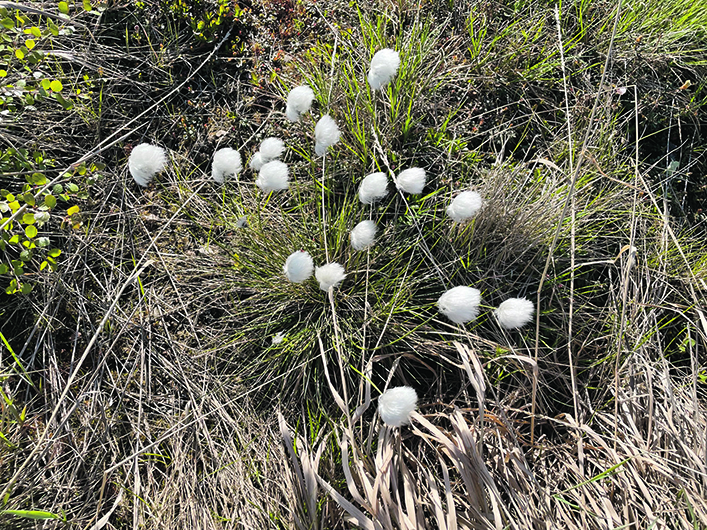
Fireweed grows wild everywhere in North America and is the Yukon’s official flower. It gains its name from the fact that it is one of the first plants to grow after a forest fire. Every part of the plant is edible, and the nectar-rich flowers produce high-grade honey.
We bought a jar of fireweed jelly that was made from the brilliant pink flowers. The delicate rosy-pink jelly has a unique taste — sweet yet tangy, floral yet fruity. With the devastating forest fires this year, there will be an abundance of fireweed in the coming years, proving an opportunity to make some jelly.
Fireweed Jelly
Makes six to seven half-pint (250 mL) jars.
- 8 c. fireweed blossoms and buds, lightly packed 2 L
- 5 c. water plus more if needed 1.2 L
- 1/4 c. lemon juice 60 mL
- 2 packages (57gms/2 oz. each) powdered pectin
- 5 c. sugar 1 kg
When harvesting, select a location far from roadways and contamination from vehicle exhaust fumes, but not so far as to get lost.
To harvest fireweed blossoms, first shake flower stalks to remove any little critters or bugs.
Pinch fresh blossoms from stem, leave shriveled and spent blossoms. Work upward stripping off blossoms and buds right to the tip of the flower stalk. At home transfer picked flowers to a large bowl of cold water.
Agitate flowers to remove debris, carefully pour off the water. Repeat this process at least twice. Place in a salad spinner to spin and drain flowers.
Put blossoms and five cups of water into a large saucepan. Bring to a boil, reduce heat to medium-high and boil, uncovered, 10 minutes. Cool mixture. Cover and refrigerate overnight if necessary.
The mixture will be a dull purple or muddy brown colour at this point.
Prepare seven half-pint (250 ml) jars for canning; wash and sterilize them either in a boiling water bath or in oven at 225 F (110 C). Put matching snap top lids into a small saucepan of hot water and keep warm on medium-low heat on stovetop. Fill canner with water and heat.
Strain blossoms through a jelly bag or several layers of cheesecloth. Squeeze as much liquid out as possible and discard blossoms. Top up fireweed juice with water to make four cups (960 mL).
Add lemon juice to fireweed liquid and watch the magenta colour of the blossoms return, a bit of natural magic.
Pour liquid into a large pot. Add pectin and whisk to dissolve lumps. Bring liquid to a boil, add sugar. Bring back to a rolling boil and boil hard for one minute.
Pour jelly into sterilized jars, wipe jar rims with a clean damp cloth, add snap lids and rings and seal until finger-tight, only as tight as you can get them with your thumb and forefinger.
Process jars in a boiling water bath for 10 minutes. Then set onto a tea towel on counter and leave undisturbed for 24 hours.
Adapted from Margaret Bose Johnson from Stony Plain, Alta., www.kitchenfrau.com.
Betty Ann Deobald is a home economist from Rosetown, Sask., and a member of Team Resources. Contact: team@producer.com.


